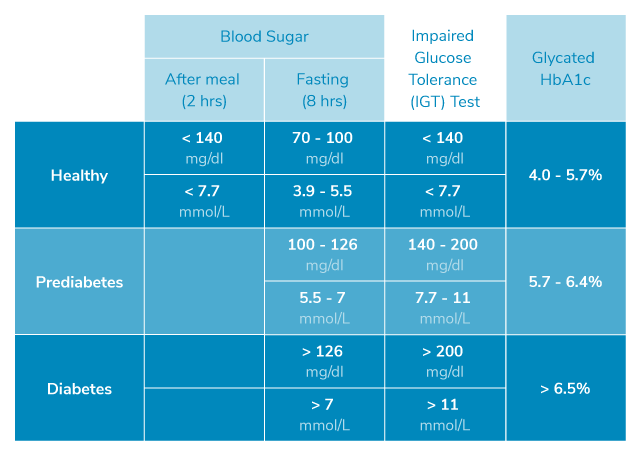
Blood Sugar 101
Glucose (blood sugar) is essential for our survival. It is one of the most important sources of energy that all cells rely on. Glucose comes from our diet, specifically carbohydrate foods. After a meal, carbohydrates inside food are broken down into glucose molecules. Glucose then travels through the blood from our digestive system into cells of other parts of the body, where they use glucose as an energy source to maintain life functions.
But the diabetes epidemic since the 1980s [1] has highlighted the importance of overnutrition as a cause of modern lifestyle diseases. Maintaining healthy blood sugar levels has become a crucial part of healthy living, as uncontrolled blood sugar can lead to irreparable damage and numerous complications.
Measuring blood sugar
Blood sugar level measures the concentration of glucose in your blood, often shown as milligrams of glucose in 1 deciliter of blood (mg/dl), or mmol of glucose in 1 liter (mmol/L). 1mmol/L glucose is equivalent to 18.02mg/dl. Because blood sugar can rise and fall quickly between meals, the timing of taking a blood sample is important. A healthy level is between 70 - 100 mg/dl (3.9 - 5.5 mmol/L) after an 8-hour fast, and below 140 mg/dl (7.8 mmol/L) when measured 2 hours after a meal. It is important to measure both fasting and post-meal levels as blood sugar can rise from 70 mg/dl before a meal to above 140 mg/dl after a meal.
For more accurate diagnosis, the Impaired Glucose Tolerance (IGT) test may be used. After a fasting glucose level has reached below 126 mg/dl, 75g of glucose is eaten, and the blood sugar level is measured 2 hours later. Levels below 139 mg/dl is normal, 140 to 199 indicates prediabetes, and 200 mg/dl or above is diagnosed as diabetes. If fasting glucose level is above 126 mg/dl, it is also diagnosed as diabetes.
Another measure of blood sugar level is glycated HbA1c. HbA1c refers to hemoglobin inside red blood cells. If the blood sugar level is consistently high, glucose molecules bind to hemoglobin, forming glycated HbA1c. A high percentage of glycated HbA1c means that a lot of excess glucose has been circulating in the blood for approximately the past 3 months [2]. Unlike blood sugar concentration, this process is slow and irreversible and does not fluctuate between meals, giving an overview of blood sugar levels for the past 2-3 months.
Red blood cells only live for 2-3 months [3], so glycated HbA1c should be measured at least every 2-3 months to accurately track blood sugar history. A healthy level is between 4.0% - 5.7%, and the target level for diagnosed diabetics should be below 6.5%. However, the lifespan of red blood cells may be shorter in different individuals (shorter lifespan will show lower HbA1c levels [4]), so having a consistent record over time will give a better picture of how well an individual has been managing his/her blood sugar levels.
Responding to changing blood sugar levels
Blood sugar level must be maintained within a certain range to ensure health. If too low, cells lose the energy they need to survive, and this can lead to shock. If too high, cells become stressed and inflamed so that they cannot function normally. Thankfully, our body has built-in mechanisms to restore healthy blood sugar levels from short periods of highs and lows.
The pancreas maintains blood sugar levels by secreting two opposite hormones - insulin when the level is too high, and glucagon when the level is too low.
When there is too much glucose, insulin…
Encourages muscle and fat cells to take up more glucose and use it to create energy
Directs the liver and muscle to convert and store glucose into glycogen (large clumps of glucose)
Directs the liver and specialized fat-storing cells to convert glucose into triglycerides (fat)
As glucose is used or converted, the amount of sugar in the blood decreases.
In contrast, when there is demand for more glucose, glucagon instructs the liver to convert glycogen back into glucose, which is released into the bloodstream and transported into hungry cells. This increases the blood sugar level.
Today, it is easier to overindulge than undereat sugar-rich food, because sugar is so ubiquitous that you may not be aware of where they are. It is easy to think of sugary snacks and drinks as the only source, but sugar can be ‘hidden’ in food that often don’t taste sweet. For example, beer and wine increase blood sugar levels significantly. Sugar is also often added to salty and spicy menus or sauces to balance out the flavor, which you may not be aware of when you are eating at restaurants. Not to mention, the carbohydrates in pasta, bread and rice are all eventually digested into sugar. In addition, fruits, although they are considered to be healthy snack alternatives, can contain a high percentage of sugar that contribute to high blood sugar levels.
Interestingly, diabetes is not only affected by high blood sugar, but also a high fat diet. The body can gradually become unable to control blood sugar levels by itself because of fat build-up in our organs. Hence it is only the easier for blood sugar levels to become too high.
Therefore, for people who have abundant food options, being aware of the sugar content in food, and maintaining a healthy blood sugar level, must become a part of daily healthcare like brushing one’s teeth.
Sources:
https://dx.doi.org/10.1016/S0140-6736(16)00618-8
https://dx.doi.org/10.1088/1752-7163/aa9081
https://dx.doi.org/10.1177/1932296816659885
https://dx.doi.org/10.1182/blood-2008-04-154112



